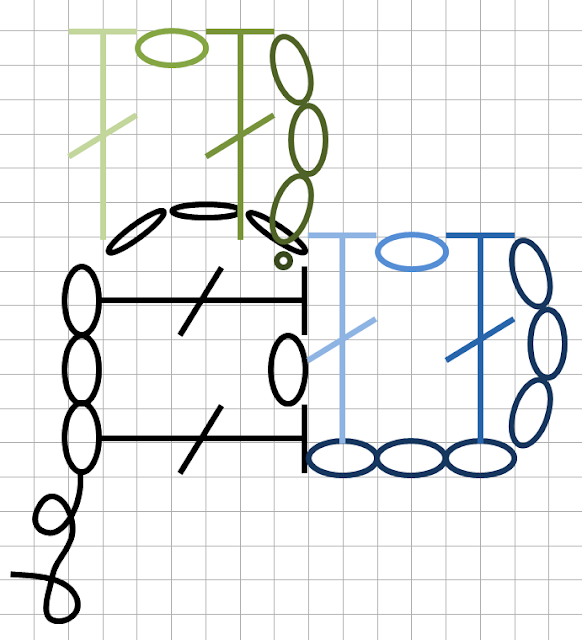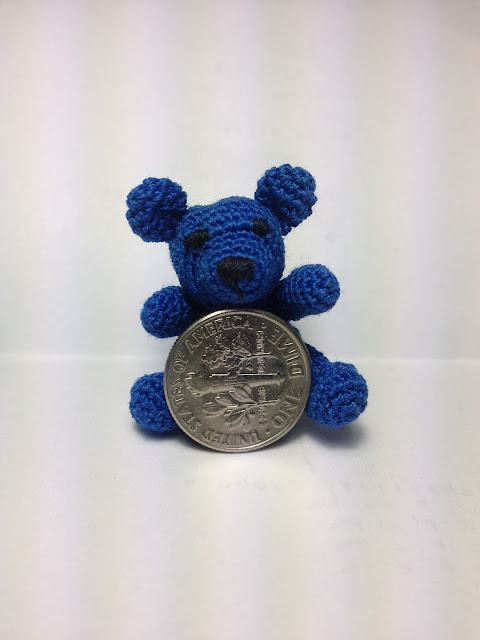I recently discovered the bullion stitch. I love that I'm always finding new stitches and techniques to try but some of them are a real mess. It looks amazing, but it's such a huge pain to make that I doubt I will be using them for anything extensive in the near future. Mine were coming out looking like demented little tornadoes with all the loops popping off.
So here are two ways I've come up with to make a bullion-looking stitch without so much hassle:
1. The yarn over/horizontal puff stitch method
 |
| One row complete |
 |
| Three rows complete |
This looks pretty similar to the bullion stitch and you can adjust the height and how many loops you want wrapped around it. You may have to poke the yarn on top a bit to get the loops into perfect position. You can see on my little swatch that you have some half-looking loops, but that is fully correctable. I didn't do anything fancy here, just worked three rows and worked each stitch in between the two below it, but you could work them right on top of each other and also include a single crochet or half double crochet row between the bullion stitches depending on how you want it to look. I think it looks like a lot of little blue captain crunches.
This method is worked very similarly to how you would make a puff stitch, a lot of yarn overs and pulling loops up into the same space. The difference here is that instead of working directly into a stitch from the row below, you'll make a chain and work around the chain as if you're doing a post stitch. I have a lot of notes in the 'pattern' below because you can make a ton of variations for this depending on how you want to do it.
Directions: I started by chaining an odd number so that I would have a chain to skip between each stitch as these are bulky. (You could also make a single crochet foundation row that might be a little easier to work into.) After the last chain, chain 3 more (or chain a lot more if you want a super tall stitch - it's totally up to you!) that will act as your first post. Then yarn over, and reach the hook around the back of the chain as if you're working a post stitch and pull up a loop (3 loops on the hook). Then you want to repeat this yarning over and pulling up a loop around the back of your chain a few more times (I did a total of three yarn over/loop pull ups around my 3 chains which will give you 7 loops on your hook, as 2 new loops are added for every repetition of yarn over/pull up loop.) Then I yarned over one more time and pulled up a loop into the same beginning chain that I made my initial chain 3 into. This is to secure the base of your stitch to the starting chain. Then using the loop you just pulled up, continue pulling it through all of the loops you've created on your hook with the yarn over/pull ups. (It may be easier to yarn over one more time and use that loop to pull through all the loops but I think it looks a little cleaner to do it the other way.)
To work more stitches, I chose to skip the next chain and insert my hook into the second chain away and chain 3 with the working yarn. This way, you have nothing connecting your stitches in between them. You could make a really convenient crochet hook holder with these stitches because you can weave something big back and forth between the bullions very easily. One additional variable you can throw in is that instead of chaining 3 for a post at the beginning of each stitch, you can work a double or triple crochet if you prefer that to chaining. If you still want all your stitches to have spaces between, then be sure to wrap your hook fully around your double crochet including the yarn over bar. This can be a little tricky because you're putting a lot of bulk into a small area and it's hard to see the bar. The big difference is that the chain 3 will make the stitch a little flatter and the double crochet will make it a little fatter, so you decide if you want it flat or round. One very last cool thing about this: if you weave your hook back and forth between these stitches after completing a row, it almost acts like a ribbing where half the stitches are pushed forward and half are pushed back and your hook will disappear in the middle. Cool possibilities!
2. The double bullion/hairpin lace method
 |
| One row complete (into single crochet foundation row) |
 |
| Two rows complete, you can see the right and wrong side |
This method is similar to the other one, but you work your steps in a bit of a reverse order. You start the same way by chaining/foundation chaining to set up, then either chain a few stitches or work a double crochet and work around it like a post. The difference here is that instead of starting with a yarn over, you'll start by pulling up a loop around the back of your post, then yarning over and pulling through that loop and repeating, so you'll be working one half of the double bullion as you work around the post, and then at the end, you'll complete the second half by drawing through all the loops on your hook. These have a 'double' look, or when scrunched together, look like double the amount of thinner stitches. I say this is a hairpin lace method because the front and back do not look exactly alike, and there is a definite right side/wrong side when you use this one. The back looks like a little hairpin lace or skeleton ribs to me.
Directions: Set up some chains or single crochet foundation row. I worked into an odd number (but you can see in the photos that my side stitches bulge out a little, so maybe add a few?) and left one chain between each stitch. To begin each stitch, either chain however many you want tall (I used 3) or double/triple crochet. Now reach your hook around the back of the chain like a post stitch and pull up a loop. Yarn over and pull through that one loop. Then repeat pulling up a loop around the back and pulling a loop through it, each time adding one more loop to your hook. When you have reached the bottom of your chain or double crochet, pull up a loop in the chain or stitch below your work to secure the stitch in place, then either pull that loop up and through all the loops or pull another loop through that one and then through all the others.
To work more stitches, skip one chain or stitch and work into every other stitch across your row.
You can see in the photo above that there is a right side/wrong side here, where you can see little bumps in the middle of your stitch in the wrong side. You might want to work alternating rows of this stitch and single crochet or half double or something in order to keep your right sides facing out.
As far as I know, you can do everything with these two stitches that you could with a regular bullion stitch without the hassle. Yay!


















